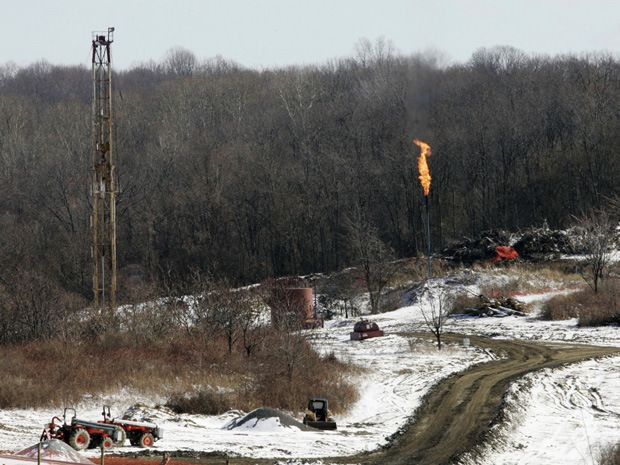Fracking Debate: EPA Staffer Linked Methane Contamination To Fracking In Internal Docs

The debate over fracking's effect on the environment continues to rage in the public sphere – and, as newly uncovered documents show, within the U.S. Environmental Protection Agency itself.
The Los Angeles Times recently obtained a PowerPoint presentation on the water quality in Dimock, Pa., given by staff from an EPA office in Philadelphia. Dimock is a township that attracted national attention starting in 2009 when methane was found in 13 of its water wells. The presentation, which is based on data collected over more than four years by both Pennsylvania authorities and the EPA, says methane and other gases released during natural gas drilling “apparently cause significant damage to the water quality.”
Methane is the primary ingredient in natural gas, and threatens both explosion and asphyxiation when in enclosed spaces, though its long-term impact on human health is not well understood. It’s thought that methane and other contaminants can creep into water supplies through flaws in drilling wells.
Dimock residents’ fears for their water quality featured prominently in the 2010 documentary "Gasland." That was also the year that Pennsylvania’s Department of Environmental Protection said Dimock’s water problems stemmed directly from natural gas drilling by Cabot Oil & Gas Corp.
The EPA sampled private wells serving 64 homes between January and June 2012, but shut down its investigation of Dimock’s drinking water that July. At the time, the agency said there were not enough contaminants in the water to justify any additional action. Now, it appears that some EPA staffers wanted their superiors to do more.
"Methane is at significantly higher concentrations in the aquifers after gas drilling and perhaps as a result of fracking and other gas well work," the presentation says, according to the LA Times.
The PowerPoint says the methane contamination found in five wells is a chemical match for the methane from the Marcellus shale formation that’s the target of hydraulic fracturing (i.e. fracking) and drilling.
"This presentation represents one [on-scene coordinator's] thoughts regarding 12 samples and was not shared with the public because it was a preliminary evaluation that requires additional assessment in order to ascertain its quality and validity," EPA spokeswoman Alisha Johnson told the LA Times. "The sampling and an evaluation of the particular circumstances at each home did not indicate levels of contaminants that would give EPA reason to take further action.”
Johnson also noted in an email to Bloomberg News that the data and conclusions in the PowerPoint have not been peer-reviewed.
National Resources Defense Council staffer Kate Sinding said in a blog post on Saturday the LA Times’ revelations cast the EPA’s closure of its investigation in Dimock in a troubling light. She also noted that the EPA’s July 2012 announcement marking the end of its sampling did not even mention the word “methane.”
“The leaked report made public … suggests that EPA basically declared that Dimock residents’ water was okay to drink, despite the fact that some of its own staff believed that it showed serious contamination, possibly from fracking, that was likely to persist for a long time,” Sinding wrote. “It suggests that EPA’s own consultants, and perhaps field staff, believed not only that the Dimock aquifer had been contaminated by high levels of methane from the Marcellus Shale.”
In June, scientists from Duke University published a study that found 82 percent of 141 drinking water wells in cities and towns around the Marcellus Shale were contaminated with methane. Concentrations of methane increased much more in close proximity to the wells. Drilling advocates, however, point to the presence of naturally occurring methane in Pennsylvania drinking water, saying that casts doubt on how the industry is really affecting water quality. Cabot maintains that the methane found in Dimock's water was around long before it started drilling.
Pennsylvania is one of two states in the U.S. that does not set statewide standards for construction of private water wells. And some water wells in rural parts of the state already had water-quality problems before the drilling. Of 233 water wells tested in a March 2012 Pennsylvania State University report, 40 percent failed at least one safe drinking water standard (most commonly, bacterial contamination).
© Copyright IBTimes 2024. All rights reserved.





















